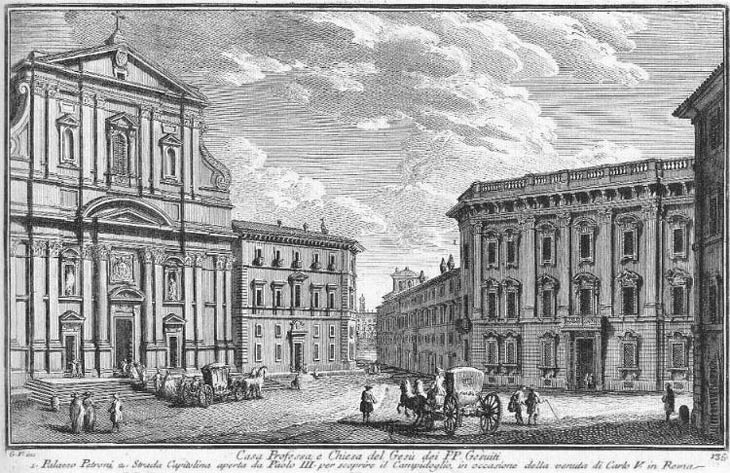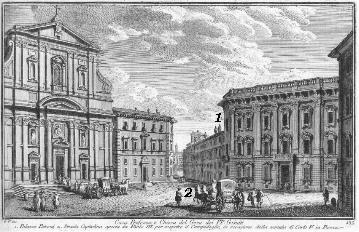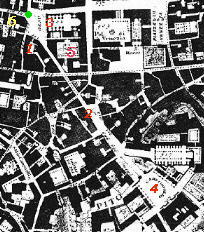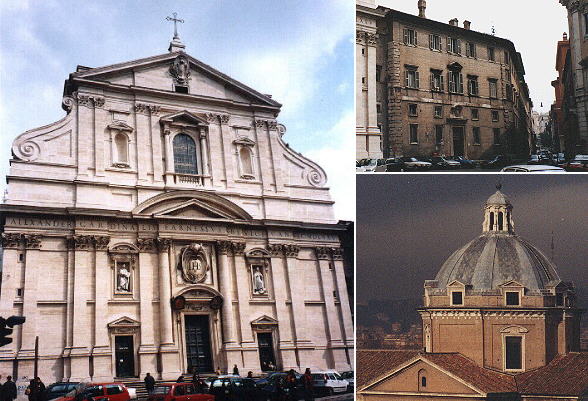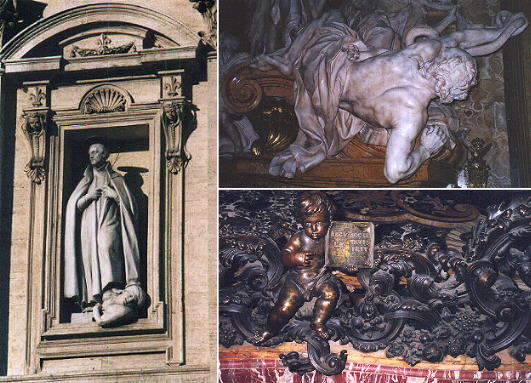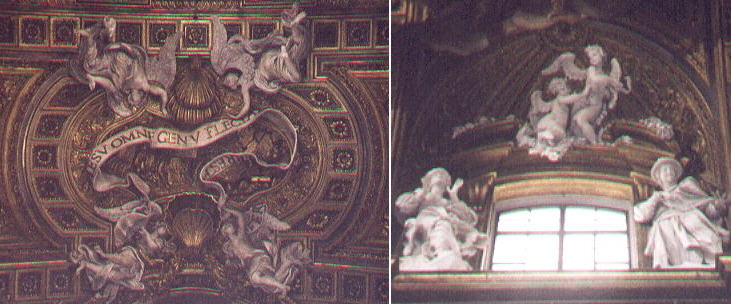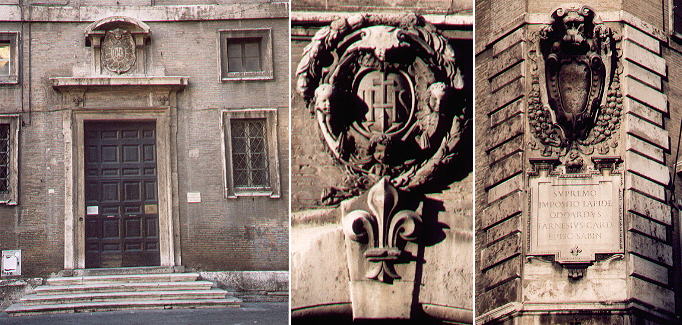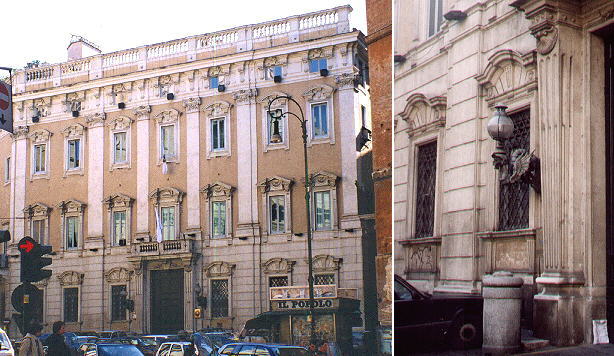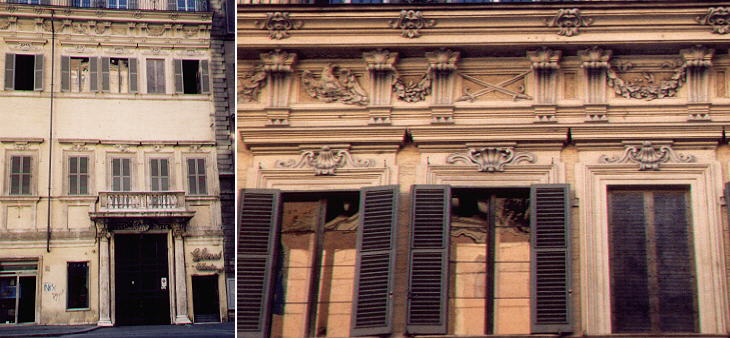

Chiesa del Gesù (Book
7) (Map
C3) (Day 1) (View C7) (Rione Pigna)
In this page:
The plate by Giuseppe Vasi
Today's view
Chiesa del Gesù
Casa Professa
Palazzo Cenci Bolognetti
Palazzo Celsi Viscardi
The Plate (No. 135)
Cardinal Alessandro Farnese erected on the square designed by Paulus
III Farnese to provide an appropriate entrance to the Capitol,
this very large church which for many aspects opens the Baroque period
in Rome, chiefly for its rich internal decoration. The view is taken from the green dot in the 1748 map below.
In the description below the plate Vasi made reference to: 1) Palazzo Petroni (Cenci Bolognetti); 2) Street leading to the Capitol.
The map shows also 3) Chiesa del Gesù; 4) Palazzi Capitolini; 5) Casa Professa; 6) Palazzo Celsi Viscardi.
Today
Today Piazza del Gesù is one of the busiest crossroads of
Rome, because traffic is still channeled through the street opened by Paulus
III to allow the passage of the horse of Charles V. The dome was designed by Iacopo Barozzi known as il Vignola, but it was built
under the direction of Giacomo della Porta. The church was completed in 1584.
Read Henry James's account of his visit to il Gesù in 1873.
Read William Dean Howells' account of his visit to il Gesù in 1908.
Chiesa
del
Gesù
The nice façade by Giacomo Della Porta shows a statue of St. Ignatius
with a striking contrast between the total placidity of the face of the
Saint and the rather violent action he is performing. The interior was very richly decorated and contains
many paintings and sculptures. The Jesuits were great supporters of the use of images aimed
at preaching to the less educated believers. They also thought that the richness of the decoration was an
appropriate means to celebrate the greatness of God, so the altar dedicated to St Ignatius (late XVIIth century) is the richest one in Rome.
The picture above shows Heresy by Piere Legros and a detail of the balustrade. The ceiling was
decorated by Giovanni Battista Gaulli known as il Baciccio.
His frescoes are framed by a complex decoration by Antonio Raggi and Leonardo Retti,
both associates of Gian Lorenzo Bernini. Their stucco angels seem to float in the air.
The presence of statues representing Chinese characters celebrates the successes obtained by the Jesuits in the Far East.
Casa
Professa
A few years later another Farnese cardinal, Odoardo Farnese, provided the Jesuits with a large building designed by Girolamo Rainaldi
for their headquarters (Casa Professa). The building incorporated the small house where St. Ignatius spent his last years.
In 1932 the southern façade was pulled down and rebuilt reducing the size of Casa Professa.
Palazzo
Cenci
Bolognetti
Palazzo Petroni, today Cenci-Bolognetti is a minor work by Ferdinando
Fuga, where the architect devised an original decoration for the portal with pillars inclined towards the top. The palace is important from a historical viewpoint
due to recent events. Here were the headquarters
of the Christian Democratic Party which for more than forty years after
World War II led government coalitions in Italy. So for many Italians Piazza
del Gesù was a synonym of the Government itself.
Palazzo
Celsi
Viscardi
In the 1880s the narrow street linking Piazza del Gesù with
Palazzo Cesarini was enlarged by pulling down the buildings on its northern side.
The buildings on its southern side were to a different degree modified to suit the taste of the period.
Palazzo Celsi Viscardi retained its previous appearance: the building was erected in 1678 by
Giovanni Antonio De Rossi for the Celsi, but the Viscardi, who acquired the palace in the early XVIIIth century
decorated it with their heraldic symbols.
Excerpts from Giuseppe Vasi 1761 Itinerary related to this page:
Chiesa del Gesù
Insigne trofeo è questo gran tempio della pietà di Alessandro Card. Farnese, e la
Casa professa de' PP. Gesuiti, che l’è unita di Odoardo Card. Farnese, i quali uno dopo
l'altro fecero a gara per favorire le imprese del santo Fondatore. Eran quivi due piccole,
chiese, una dove è la casa, dicevasi s. Maria in Astalli, e l'altra dove è la chiesa era
dedicata a s. Andrea Apostolo, le quali ottenne s. Ignazio da Paolo III. onde abbracciando
tutto quel sito nell'anno 1543. gettò i fondamenti della Casa professa, e nel 1568. quelli
della chiesa col disegno di Giacomo Barozio da Vignola; il prospetto però, è di Giacomo della
Porta di lui allievo. E’ ammirabile questa chiesa non solo per la sua vastità, ma molto più
per li ornamenti di pittura, di scultura, di marmi, e stucchi dorati, specialmente per la
gran volta, tribuna, e cupola dipinti egregiamente dal Baciccio, altresì per la preziosissima
cappella di s. Ignazio ricca di marmi preziosi, argenti, e metalli lavorati egregiamente, e
perchè troppo nojoso mi renderei se volessi quì notare tutte le sue parti, accennerò solamente
le cose principali. Il s. Andrea Apostolo con altre pitture nella prima cappella a destra è
del Ciampelli; il s. Francesco Borgia nella seconda è del P. Pozzi Gesuita, e le pitture a
fresco sono del Cav. Celio; i sette Angioli nella terza sono di Federigo Zuccheri ed il
s. Francesco Saverio nella crociata è del Cav. Maratta; l'altare però è nobile disegno di
Pietro da Cortona, e le pitture in alto sono del Carboni: entro l'ovato di metallo sostenuto
da un Angiolo simile si custodisce un braccio del Santo, ed altrove parte del corpo di
s. Francesco Borgia. La cappelletta, che siegue ornata di bellissime colonne è disegno di
Giacomo della Porta, il quale fece ancora il disegno dell'altare maggiore, in cui si vede
il quadro dipinto dal Muziano, e a destra il deposito del Card. Bellarmino fattovi dal
suddetto Card. Odoardo col disegno del Cav. Rinaldi; le statue però sono di Pietro Bernini.
La cappelletta, che siegue è disegno similmente di Giacomo della Porta; ed il grande
altare di s. Ignazio nella crociata è disegno del P. Pozzi Gesuita.
Questo vanta il primato fra tutti gli altari delle chiese di Roma, non solo per le
quattro colonne incrostate di lapislazzoli, statue e bassirilievi di marmo e di metalli
dorati, ma ancora per la grande statua del Santo tutta di argento, e ricoperta di giove,
fatta dal modello di Monsù le Gros, e per l'ammirabile gruppo di statue colla Fede, e
le nazioni barbare, che l'adorano scolpite da Gio. Teudone, e l'altro colla Religione, che
fulmina contro gli Eretici scolpite dal detto Monsù le Gros. Si conserva sotto l'altare
il corpo di s. Ignazio entro un'urna preziosa, ed altrove parte del corpo di s. Ignazio
vescovo e martire di Antiochia. Il quadro della ss. Trinità nella cappella, che siegue è del
Bassano, la creazione degli Angioli del Salimbeni, ed il baccellino di nostro Signore e la
trasfigurazione sul Tabor di Durante Alberti; il Dio Padre però in atto di creare il mondo
è disegno del P. Fiammeri, da altri colorito. Le pitture nel basso della cappella della ss.
Vergine sono del Romanelli, e quelle dalla cornice in su sono di Niccolò Pomarancio; le
statue sono del Fancelli, del Guidi, e di Gio. Lanzoni. L'istoria di s. Pietro nell'ultima
cappella fu dipinta da Francesco Mola, e le pitture nella volta sono del Pomarancio.
E finalmente li stucchi, putti, e statue sul gran cornicione furono fatti con disegni del
Baciccio da Leonardo Reti, ed Antonio Raggi. Nella sagrestia sonovi delle pitture del
Ciampelli; il s. Francesco Saverio però sull'altare è di Annibale Caracci.
|
Next plate in Book 7: Chiesa
di S. Andrea al Quirinale
Next step in Day 1 itinerary: Chiesa
dei SS. Venanzio e Ansovino
Next step in tour of Rione Pigna: Piazza S. Marco

Go
to  or to Book
7 or to my Home
Page on Baroque Rome or to my Home Page on Rome
in the footsteps of an XVIIIth century traveller.
or to Book
7 or to my Home
Page on Baroque Rome or to my Home Page on Rome
in the footsteps of an XVIIIth century traveller.
|


